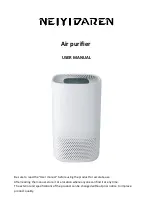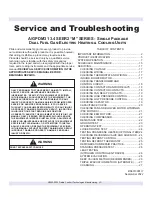
49-5000295 Rev. 1
3
IMPORTANT SAFETY INFORMATION
READ ALL INSTRUCTIONS BEFORE USING THE APPLIANCE
SAFETY
INFORMA
TION
READ AND SAVE THESE INSTRUCTIONS
WARNING
For your safety, the information in this manual must be followed to minimize the risk of
fire, electric shock or personal injury.
Ŷ8VHWKLVDSSOLDQFHRQO\IRULWVLQWHQGHGSXUSRVHDV
described in this Owner’s Manual.
Ŷ
This air conditioner must be properly installed in
accordance with the Installation Instructions before it is
used.
Ŷ
Never unplug your air conditioner by pulling on the
power cord. Always grip plug firmly and pull straight
out from the receptacle.
Ŷ
Replace immediately all electric service cords that
have become frayed or otherwise damaged. A
damaged power supply cord must be replaced with a
new power supply cord obtained from the manufacturer
and not repaired. Do not use a cord that shows cracks
or abrasion damage along its length or at either the
plug or connector end.
Ŷ
Turn the unit OFF and unplug your air conditioner
before cleaning.
Ŷ
For your safety…do not store or use combustible
materials, gasoline or other flammable vapors or
liquids in the vicinity of this or any other appliance.
Ŷ
If the receptacle does not match the plug, the
receptacle must be changed out by a qualified
electrician.
Ŷ'RQRWXVHPHDQVWRDFFHOHUDWHWKHGHIURVWLQJSURFHVV
or to clean, other than those recommended by the
manufacturer.
Ŷ
The appliance shall be stored in a room without
continuously operating ignition sources (for example:
open flames, an operating gas appliance or an
operating electric heater.
Ŷ
Do not pierce or burn refrigerant tubing. Be aware that
refrigerants may not contain an odor.
Ŷ
Keep ventilation openings clear of obstruction.
Ŷ
When handling, installing, and operating the appliance,
care should be taken to avoid damage to the
refrigerant tubing.
Ŷ
Do not drill holes in the unit.
Ŷ
Maintenance, cleaning, and service should only be
performed by technicians properly trained and qualified
in the use of flammable refrigerants.
Ŷ
GE Appliances does not support any servicing of the
air conditioner.
Ŷ
Dispose of air conditioner in accordance with Federal
and Local Regulations. Flammable refrigerants require
special disposal procedures. Contact your local
authorities for the environmentally safe disposal of your
air conditioner.
WARNING
Risk of Fire or Explosion. This unit contains flammable refrigerant.
Additional safety precautions must be followed.
WARNING
USE OF EXTENSION CORDS
RISK OF FIRE. Could cause serious injury or death.
Ŷ'2127XVHDQH[WHQVLRQFRUGZLWKWKLV:LQGRZ$LU
Conditioner.
Ŷ'2127XVHVXUJHSURWHFWRUVRUPXOWLRXWOHWDGDSWRUV
with this Window Air Conditioner.
HOW TO CONNECT ELECTRICITY
Do not, under any circumstances, cut or remove the third
(ground) prong from the power cord. For personal safety,
this appliance must be properly grounded.
DO NOT use an adapter plug with this appliance.
The power cord of this appliance is equipped with a
3-prong (grounding) plug which mates with a standard
3-prong (grounding) wall outlet to minimize the possibility
of electric shock hazard from this appliance.
Power cord includes a current interrupter device. A test
and reset button is provided on the plug case. The device
should be tested on a periodic basis by first pressing the
TEST
button and then the
RESET
button while plugged
into the outlet. If the
TEST
button does not trip or if the
RESET
button will not stay engaged, discontinue use of the
air conditioner and contact a qualified service technician.
Have the wall outlet and circuit checked by a qualified
electrician to make sure the outlet is properly grounded.
Where a 2-prong wall outlet is encountered, it is your
personal responsibility and obligation to have it replaced
with a properly grounded 3-prong wall outlet.
The air conditioner should always be plugged into its
own individual electrical outlet which has a voltage rating
that matches the rating plate.
This provides the best performance and also prevents
overloading house wiring circuits which could cause a
fire hazard from overheated wires.
See the Installation Instructions,
Electrical
Requirements
section for specific electrical connection
requirements.




































